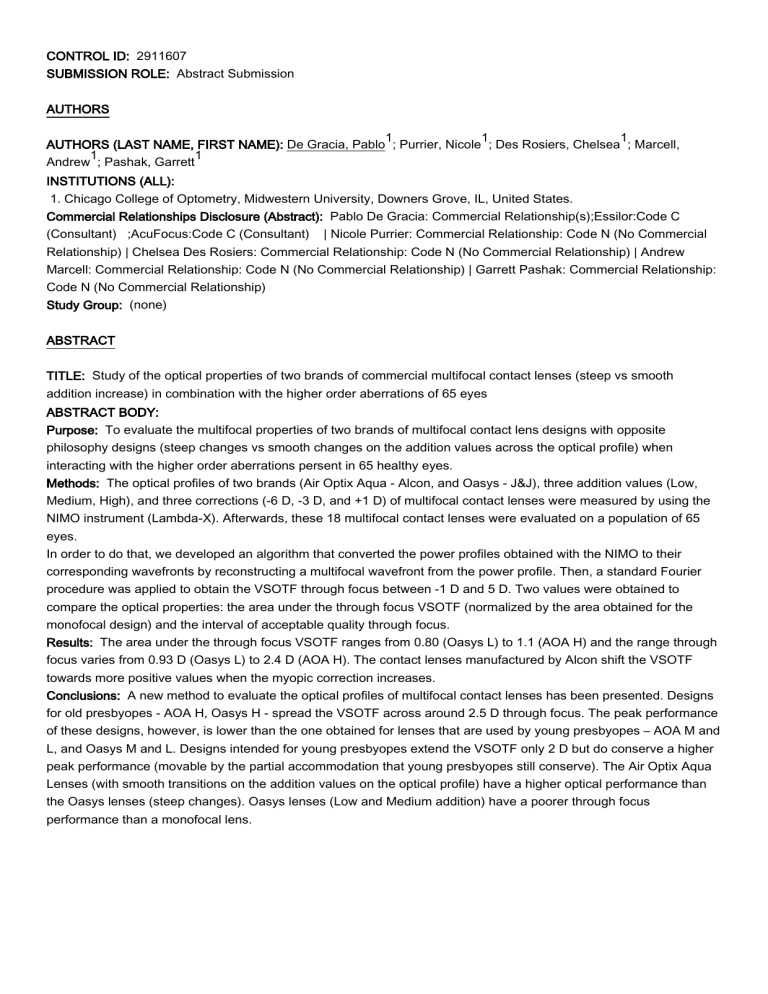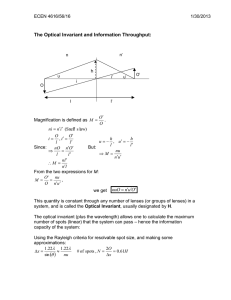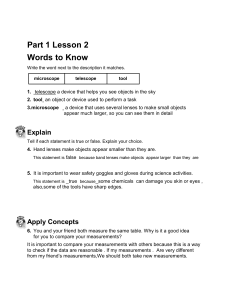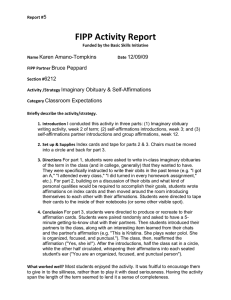
CONTROL ID: 2911607 SUBMISSION ROLE: Abstract Submission AUTHORS 1 1 1 AUTHORS (LAST NAME, FIRST NAME): De Gracia, Pablo ; Purrier, Nicole ; Des Rosiers, Chelsea ; Marcell, 1 1 Andrew ; Pashak, Garrett INSTITUTIONS (ALL): 1. Chicago College of Optometry, Midwestern University, Downers Grove, IL, United States. Commercial Relationships Disclosure (Abstract): Pablo De Gracia: Commercial Relationship(s);Essilor:Code C (Consultant) ;AcuFocus:Code C (Consultant) | Nicole Purrier: Commercial Relationship: Code N (No Commercial Relationship) | Chelsea Des Rosiers: Commercial Relationship: Code N (No Commercial Relationship) | Andrew Marcell: Commercial Relationship: Code N (No Commercial Relationship) | Garrett Pashak: Commercial Relationship: Code N (No Commercial Relationship) Study Group: (none) ABSTRACT TITLE: Study of the optical properties of two brands of commercial multifocal contact lenses (steep vs smooth addition increase) in combination with the higher order aberrations of 65 eyes ABSTRACT BODY: Purpose: To evaluate the multifocal properties of two brands of multifocal contact lens designs with opposite philosophy designs (steep changes vs smooth changes on the addition values across the optical profile) when interacting with the higher order aberrations persent in 65 healthy eyes. Methods: The optical profiles of two brands (Air Optix Aqua - Alcon, and Oasys - J&J), three addition values (Low, Medium, High), and three corrections (-6 D, -3 D, and +1 D) of multifocal contact lenses were measured by using the NIMO instrument (Lambda-X). Afterwards, these 18 multifocal contact lenses were evaluated on a population of 65 eyes. In order to do that, we developed an algorithm that converted the power profiles obtained with the NIMO to their corresponding wavefronts by reconstructing a multifocal wavefront from the power profile. Then, a standard Fourier procedure was applied to obtain the VSOTF through focus between -1 D and 5 D. Two values were obtained to compare the optical properties: the area under the through focus VSOTF (normalized by the area obtained for the monofocal design) and the interval of acceptable quality through focus. Results: The area under the through focus VSOTF ranges from 0.80 (Oasys L) to 1.1 (AOA H) and the range through focus varies from 0.93 D (Oasys L) to 2.4 D (AOA H). The contact lenses manufactured by Alcon shift the VSOTF towards more positive values when the myopic correction increases. Conclusions: A new method to evaluate the optical profiles of multifocal contact lenses has been presented. Designs for old presbyopes - AOA H, Oasys H - spread the VSOTF across around 2.5 D through focus. The peak performance of these designs, however, is lower than the one obtained for lenses that are used by young presbyopes – AOA M and L, and Oasys M and L. Designs intended for young presbyopes extend the VSOTF only 2 D but do conserve a higher peak performance (movable by the partial accommodation that young presbyopes still conserve). The Air Optix Aqua Lenses (with smooth transitions on the addition values on the optical profile) have a higher optical performance than the Oasys lenses (steep changes). Oasys lenses (Low and Medium addition) have a poorer through focus performance than a monofocal lens. Methodolgy used for the evaluation of the Oasys and Air Optix Aqua multifocal contact lenses. Layman Abstract (optional): Provide a 50-200 word description of your work that non-scientists can understand. Describe the big picture and the implications of your findings, not the study itself and the associated details.: This work presents the evaluation of the optical properties of two brands (Air Optix Aqua and Oasys) of commercial multifocal contact lenses when combined with the optical aberrations of 65 patients. The technical merit of this work resides on the development of a new mathematical algorithm that makes possible the evaluation of multifocal contact lenses in combination with the higher order aberrations of a population of patients, what we believe is state of the art. DETAILS PRESENTATION TYPE: #1 Paper, #2 Poster CURRENT REVIEWING CODE: 3320 physiological optics: optical design and models - VI CURRENT SECTION: Visual Psychophysics/Physiological Optics Clinical Trial Registration (Abstract): No Other Registry Site (Abstract): (none) Registration Number (Abstract): (none) Date Trial was Registered (MM/DD/YYYY) (Abstract): (none) Date Trial Began (MM/DD/YYYY) (Abstract): (none) Grant Support (Abstract): No Support Detail (Abstract): None TRAVEL GRANTS and AWARDS APPLICATIONS AWARDS: ARVO / Alcon Early Career Clinician-Scientist Research Award AFFIRMATIONS Affirmations: Affirmation of compliance with ARVO’s Statement for Use of Human Subjects and/or Declaration of Helsinki. Affirmations: Affirmation of copyright transfer from each author to ARVO, or certification of public domain abstract. Affirmations: Affirmation of compliance with ARVO’s Statement for Use of Animals. Affirmations: Affirmation to reveal essential structure, novel compound elements, or identify new gene compounds. Affirmations: Affirmation that abstract data/conclusions have not been published; not redundant with other submissions from same investigators. Affirmations: Affirmation of compliance with ARVO policy on registering clinical trials. Affirmations: Affirmation to present same work as abstract submission. Affirmations: Affirmation to pay Annual Meeting’s full registration fee. Affirmations: Affirmation that submission of this abstract has been approved by the Principal Investigator.






